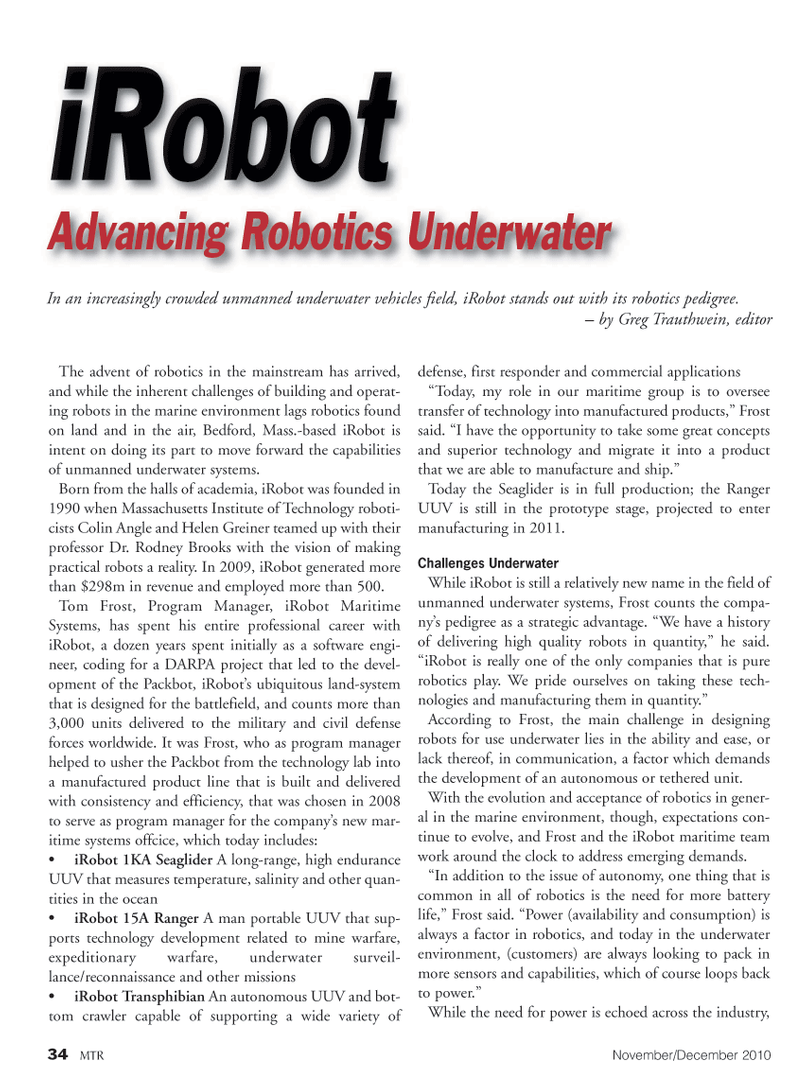
Page 34: of Marine Technology Magazine (November 2010)
Fresh Water Monitoring and Sensors(lakes, rivers, reservoirs)
Read this page in Pdf, Flash or Html5 edition of November 2010 Marine Technology Magazine
The advent of robotics in the mainstream has arrived, and while the inherent challenges of building and operat- ing robots in the marine environment lags robotics found on land and in the air, Bedford, Mass.-based iRobot is intent on doing its part to move forward the capabilities of unmanned underwater systems.
Born from the halls of academia, iRobot was founded in 1990 when Massachusetts Institute of Technology roboti- cists Colin Angle and Helen Greiner teamed up with their professor Dr. Rodney Brooks with the vision of making practical robots a reality. In 2009, iRobot generated more than $298m in revenue and employed more than 500.
Tom Frost, Program Manager, iRobot Maritime
Systems, has spent his entire professional career with iRobot, a dozen years spent initially as a software engi- neer, coding for a DARPA project that led to the devel- opment of the Packbot, iRobot’s ubiquitous land-system that is designed for the battlefield, and counts more than 3,000 units delivered to the military and civil defense forces worldwide. It was Frost, who as program manager helped to usher the Packbot from the technology lab into a manufactured product line that is built and delivered with consistency and efficiency, that was chosen in 2008 to serve as program manager for the company’s new mar- itime systems offcice, which today includes: • iRobot 1KA Seaglider A long-range, high endurance
UUV that measures temperature, salinity and other quan- tities in the ocean • iRobot 15A Ranger A man portable UUV that sup- ports technology development related to mine warfare, expeditionary warfare, underwater surveil- lance/reconnaissance and other missions • iRobot Transphibian An autonomous UUV and bot- tom crawler capable of supporting a wide variety of defense, first responder and commercial applications “Today, my role in our maritime group is to oversee transfer of technology into manufactured products,” Frost said. “I have the opportunity to take some great concepts and superior technology and migrate it into a product that we are able to manufacture and ship.”
Today the Seaglider is in full production; the Ranger
UUV is still in the prototype stage, projected to enter manufacturing in 2011.
Challenges Underwater
While iRobot is still a relatively new name in the field of unmanned underwater systems, Frost counts the compa- ny’s pedigree as a strategic advantage. “We have a history of delivering high quality robots in quantity,” he said. “iRobot is really one of the only companies that is pure robotics play. We pride ourselves on taking these tech- nologies and manufacturing them in quantity.”
According to Frost, the main challenge in designing robots for use underwater lies in the ability and ease, or lack thereof, in communication, a factor which demands the development of an autonomous or tethered unit.
With the evolution and acceptance of robotics in gener- al in the marine environment, though, expectations con- tinue to evolve, and Frost and the iRobot maritime team work around the clock to address emerging demands. “In addition to the issue of autonomy, one thing that is common in all of robotics is the need for more battery life,” Frost said. “Power (availability and consumption) is always a factor in robotics, and today in the underwater environment, (customers) are always looking to pack in more sensors and capabilities, which of course loops back to power.”
While the need for power is echoed across the industry, 34 MTR November/December 2010 iRobot
Advancing Robotics Underwater
In an increasingly crowded unmanned underwater vehicles field, iRobot stands out with its robotics pedigree. – by Greg Trauthwein, editor

 33
33

 35
35
